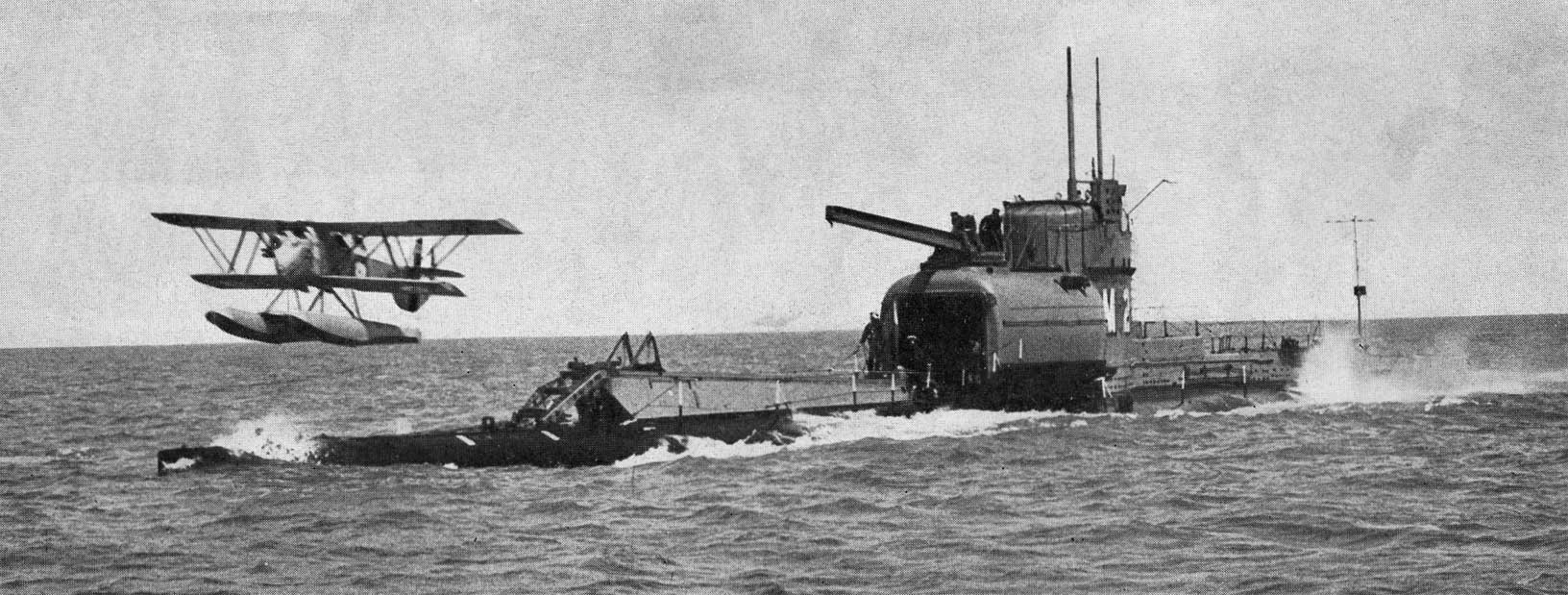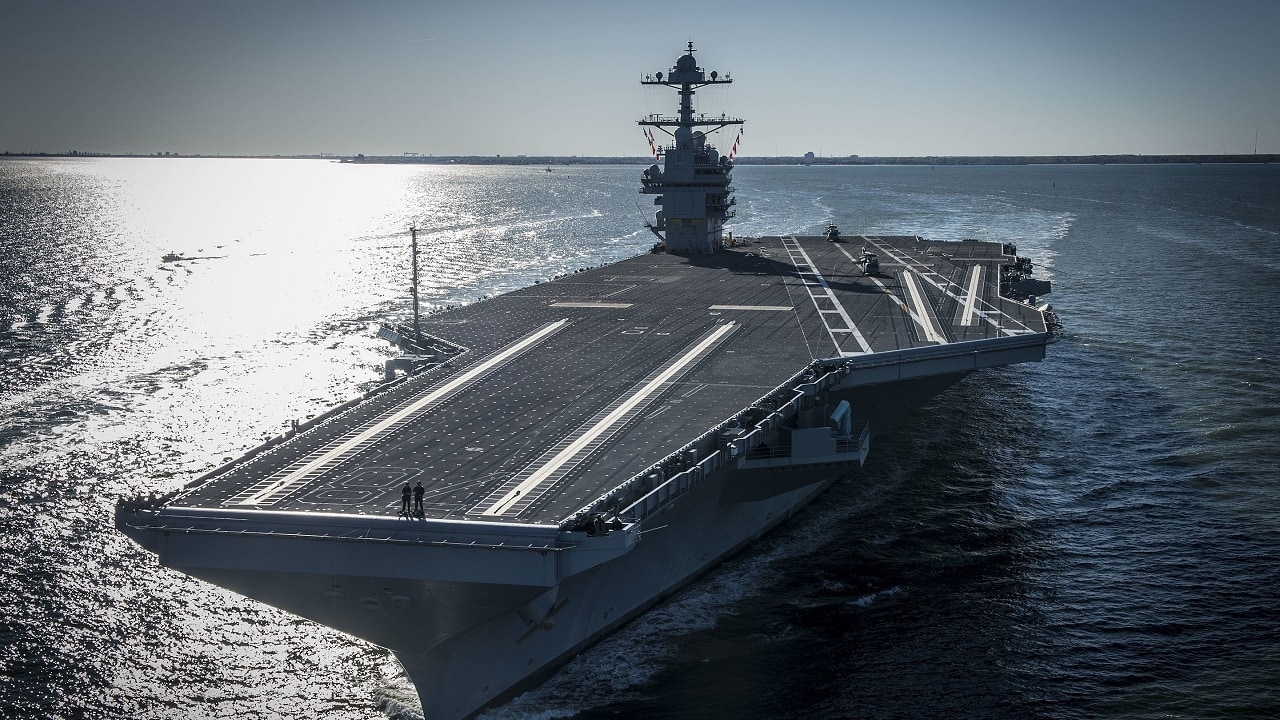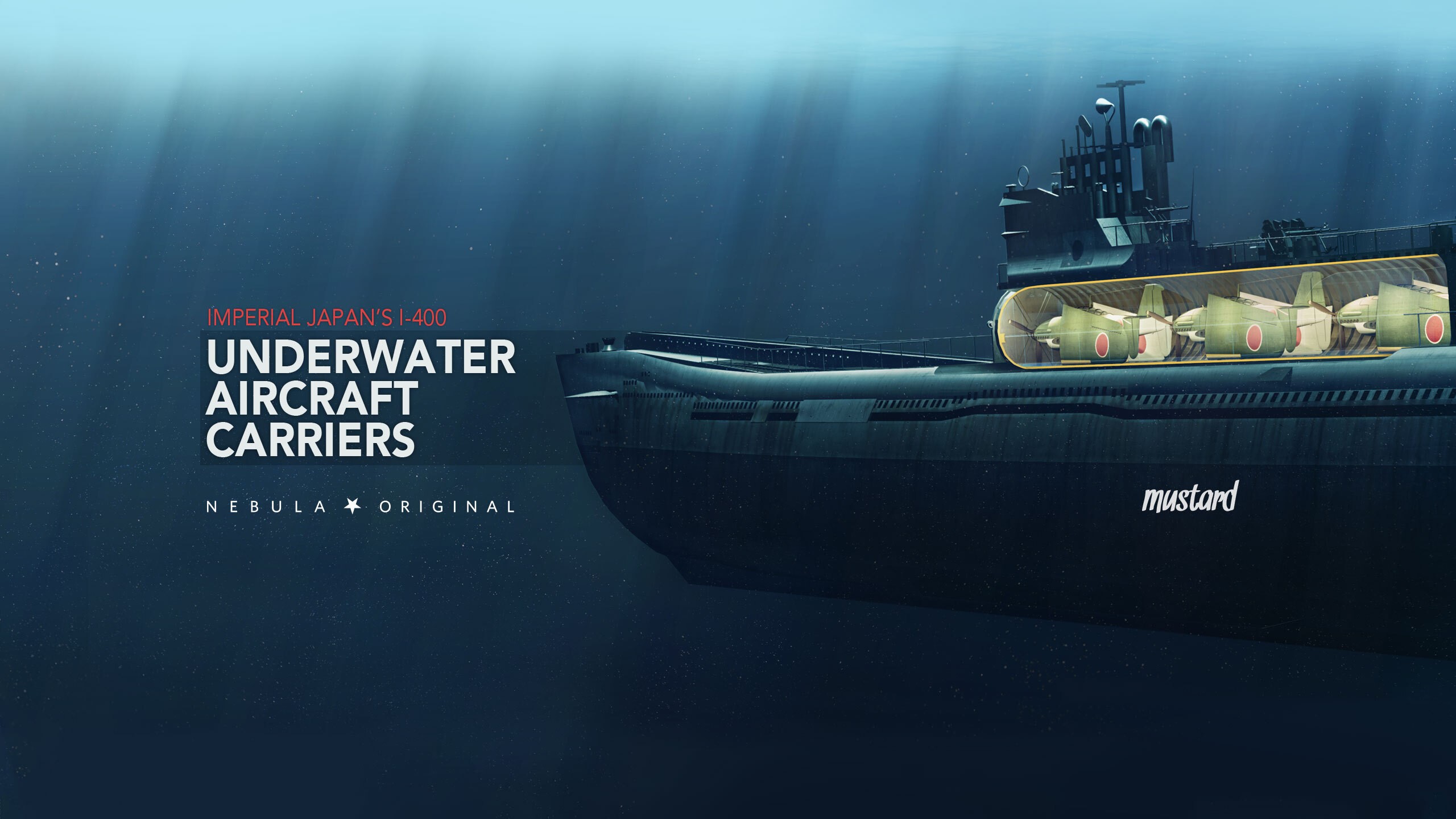Submersible Aircraft Carrier - If submarines possessed the high vision and quick speed of aircraft, they could dramatically extend their reach. If aircraft took off and landed from underwater platforms, their staging and strikes would be stealthier and more secure.
In late August 1945, about two weeks after the end of hostilities, a United States Navy destroyer intercepted the unfamiliar Japanese submarines as they made for their home port. Even the US sailors sidled alongside, they were amazed by the size of the behemoths.
Submersible Aircraft Carrier
/images/I-400_submarine.jpg)
They were much more massive than any built before them, four hundred feet in length and three times larger than typical submarines. To minimize detection risk while the Cormorant launched, the sub would release the drone underwater then sail away.
Stealthy Subsea Seabird
Compressed gas would then drive the plane to the surface where its rocket motors would fire and loft it into the sky. The battle drove a wedge of suspicion between the submariners and their new commanders, but the giant sub worked in uneasy cooperation with the Allies in the early years of the war.
Its true potential was never realized, however, due to a collision with an American freighter in 1942 which sank the Surcouf with all hands lost. Due to the precarious nature of the French crew's allegiance, many suspected that the sinking was deliberate, although no evidence was ever found to support this theory.
Isn't it strange how it is terrible what we as Americans say and do to the rest of the world but somehow it's OK for so many to hate the ugly Americans (but not their money!)????
Hoekstes said: "If a tomahawk missile is a plane, then you might argue that a V2 ballistic missile is a plane as well. Germany fired those from trucks, so they couldn't have been too far away from firing them from U-boats as well.
Stealthy Subsea Seabird
In Boris Chertok's four volume history of the Soviet space program (Rockets and People) he talks about the plundering of German technology and the revelation he got from it. They contributed little or nothing to the war effort.

All the resources the secret weapons required to develop were a tremendous drain on the system and produced little of value in return. Alternatively, AN-1 submarines could sit off the coasts of Asia and Europe and form America's first line of fighter defense against nuclear-armed intercontinental bombers, intercepting them far from the continental United States.
The uncertainty about where the aircraft carriers would pop up would have sown doubt in the enemy's mind that a surprise nuclear attack against the U.S. was feasible. Unknown to many, the U.S. The Navy has already tested flying a small recon drone called the Sea Robin, which took off from a submarine's torpedo tube in 2013. In 2016, the Navy announced it was working to send "stealthy spy drones" called Blackwings into the air from tubes on the
sub. So, submarine-launched drones are more than just a fanciful concept. Awesome article. Never heard of this, although I had heard of plans to tow V-2 rockets by U-boat to the East Coast of the U.S.
(ChickenHead brings up some interesting points on why this would not have worked). I know the Japanese planned to send high-altitude balloons, with payloads of fleas infested with plague to infect humans and cattle, across the Pacific to attack the U.S.
For the full story, read the books A Plague Upon Humanity and Body Snatchers in the Desert. The other big idea with sub-carriers is using drones to help torpedoes find their target. These types of unmanned craft launch out of the sub's tube that usually deploys sound decoys.
These drones are small enough to burst out of the three-inch tube. They can fly with day or night video cameras to relay targeting data on enemy ships back to the sub-carrier. This model is called Advanced Weapons Enhanced by Submarine UAS against Mobile targets – AWESUM for short.
AH-HA! that would make sense. only a stupid narrow-minded insolent canuck would take that ribbing seriously. come on canadians, get off it already! we love you guys. you are like our little brother. always whining about how you are mistreated by the older siblings, glad to have us protecting you from the bullies on the block.

but you can't wait to grow-up and be just like us. let's see, twice our land mass yet 90% live within 200 miles of the U.S. border. and the entire population is less than that of the bankrupt state of California!!!
I married a Canuck. she moved here, swim with me. says something about the place Eh? But the emperor's broadcast surrender decree in August 1945 stopped the five giant subs of SubRonOne from attacking the huge U.S.
Navy anchorage at Ulithi Atoll. The Americans seized the Sen-Tokus, studied them and subsequently sank them to prevent the Soviets from discovering their secrets. Tucked away in the patent application for the drone is a hint of an unexpected side capability.
A drawing shows a Cormorant launching from a small surface ship, thus making any vessel a potential drone seaplane tender. Actually they had smaller rockets that launched from a gantry carried on the back of a U-boat.
Then there was a towable unit that carried a full-size V2 rocket that was successfully launched. Four units were under construction for an attack on New York when the war ended. On 09 September 1942, at about 6:00am Pacific War Time, a lookout on the US Oregon coast spotted a single incoming aircraft.
The small, unmarked plane sputtered and popped as it flew through the dawn mist. It slowly made its way over a heavily wooded area outside of Brookings, Oregon which was known to be particularly prone to forest fires, and its pilot Nobuo Fujita dropped a pair of 170 lb incendiary bombs from a low altitude.
Soon a column of smoke became visible from the forest as the strange plane turned around, its distinct engine noise fading back towards the ocean. But combining the two epoch-making weapons has proved difficult. Only one country really pulled it off—and too late to win a war.

But the tremendous potential of the aircraft-sub combo may make an historic comeback thanks to drones and Special Operations Forces. For a time U.S. scientists experimented with bats which had tiny incendiary devices strapped to them.
These bats were intended to be released from low flying bombers over Tokyo where they would seek shelter in wooden buildings and set them on fire. The plan was scrapped when some of the bats escaped during a test and set fire to a couple of nearby barns.
Anyway a story appeared in our local paper about their former chief. Apparently he spotted the remains of a weather balloon hanging in a tree; using his vast experience in such devices the man immediately determined it to be some sort of bomb, perhaps an incendiary device.
Being bullheaded the dude called the sheriff's bomb squad despite being told by several people the thing was harmless. The man promptly received a demotion for all his trouble. What a way to destroy such a damn interesting® article, I realize completely that everyone is entitled to an opinion, but I can see why a system like the Digg.com commenting system could work well, if done properly.
I know this is kind of off-topic, but this talk of attacks on the North American continent got me thinking.–Didn't the Germans have plans for a really big, supersonic bomber with a range that would have made reaching New York (
and possibly returning?) possible. The Russians would have built a cake that was at least 100x larger, made of potatoes, with beets instead of incendiary devices. They would have dropped it on themselves by accident and interned everyone with 100 miles who saw it happen.
My grandfather said the cat food of the day was made by real men and smelled/tasted much better. Ah, the good ole days.” NORFOLK (Aug. 16, 2019) The Nimitz-class aircraft carriers USS Dwight D. Eisenhower (CVN 69), left, and USS John C. Stennis (CVN 74) moored at Naval station Norfolk.
Making port at Naval station Norfolk is a routine activity for aircraft carriers. A Soviet designer came up with a submersible airplane. Although never built and full of technical loose-ends, U.L. Ushakov's 1934 design featured a thick, manta-ray-style wing and narrow fish-like body, complete with a conning tower.
Ushakov did not specify how he would seal the three radial engines against saltwater. 19FortyFive's Robert Farley was interviewed by Popular Mechanics' Kyle Mizokami in 2019. Farley believes the sub-carrier concept has some merit and is worth exploring further.
"A submarine platform for launching drones would stand a better chance of surviving in hostile, anti-access environments," Farley said. "While an aircraft carrier can take advantage of its speed and mobility to avoid missile attacks, it can't match the stealth of even a large submarine."
Now serving as 1945s New Defense and National Security Editor, Brent M. Eastwood, PhD, is the author of Humans, Machines, and Data: Future Trends in Warfare. He is an Emerging Threats expert and former U.S. Army Infantry officer.
It seems like missile subs are the natural development of this concept. Launching the planes isn't a problem, you just find a deserted area of the sea, surface and warm up the catapults. As long as you're not in radar range then no one will be any the wiser.
Shortly after getting underway, however, the Sen Toku and their attendant submarines were ordered to return in order to deflect an imminent Allied invasion of the Japanese homeland. The fleet turned back and steamed for the Allied base at Ulithi Atoll, but as they approached their target the crews received orders to catapult their planes into the sea and fire their torpedoes without arming them.
Japan had surrendered in the wake of a pair of atomic attacks. The war was over. Captain Ariizumi, the commander of the submarine fleet, chose suicide over the shame of surrendering to the Americans. To minimize detection risk while the Cormorant launched, the sub would release the drone underwater then sail away.
Compressed gas would then drive the plane to the surface where its rocket motors would fire and loft it into the sky. Following the expensive failures of the M2 and the Surcouf, the United States and Italy abandoned their plans to construct similar vessels.
But the Imperial Japanese Navy (IJN) managed to quietly master the art, and during the war the majority of their sub fleet included integrated aircraft hangars. Most of them— including the I-25 which launched the attack in Oregon— were single-plane hangars similar to the English and French efforts before them.
But throughout the war the IJN significantly improved upon the submersible aircraft carrier concept. The overwhelming firepower of nuclear weapons against naval forces, .css-3wjtm9{-webkit-text-decoration:underline;text-decoration:underline;text-decoration-thickness:0.125rem;text-decoration-color:#1c6a65;text- underline-offset:0.25rem;color:inherit;-webkit-transition:all 0.3s ease-in-out;transition:all 0.3s ease-in-out;}.css-3wjtm9:hover{color:#595959;text -decoration-color:border-link-body-hover;}demonstrated at Bikini Atoll in 1946, prompted the Navy to consider alternative basing schemes for aircraft.
One possibility was making jet fighters amphibious, able to take off directly from the sea, a concept that resulted in the failed Convair XF2Y Sea Dart. Another, bolder idea: placing aircraft carriers underwater. The machine supposedly would have flown out to sea, landed on its pontoons like a normal seaplane then flooded spaces within its wings and hull to sink.
Approaching its target under electrical power while submerged, the flying sub could observe using its periscope or fire its two torpedoes. Sub-Carrier: An idea whose time has come? The idea of taking the classic aircraft carrier and submarine and doing new and unique things with them has been floated for many years now.
So why not take the idea of somehow merging an aircraft carrier and submarine into one unit in some way? Aircraft carriers are flat-top floating airports and submarines lurk beneath the surface and launch torpedoes, ballistic missiles, and cruise missiles.
It's been that way for decades. But did you know it is plausible that a submarine could have a flat-top and send combat drones into the air? The "sub-carrier" would launch its aircraft and then head for the depths.
Quite a departure for undersea warfare, to be sure. But this idea could have legs someday as the Navy examines different ideas for unmanned aviation on the high seas. The current Tomahawk is far more closely related to aircraft than missiles.
It has a turbofan engine. It has surveillance capabilities. It can loiter over the battlefield and, thanks to said real-time surveillance, can be directed to attack multiple targets or the same target again if the first strike is deemed a miss.
But the emperor's broadcast surrender decree in August 1945 stopped the five giant subs of SubRonOne from attacking the huge U.S. Navy anchorage at Ulithi Atoll. The Americans seized the Sen-Tokus, studied them and subsequently sank them to prevent the Soviets from discovering their secrets.
submarine aircraft carrier concept, carrier submarines, japanese submersible aircraft carrier, futuristic submarine carrier, submarine aircraft carrier, future submarine aircraft carrier, japanese submarine aircraft carrier, submarine plane

